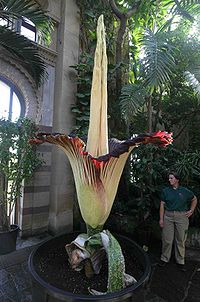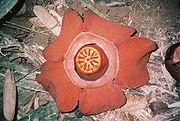
Carrion flower
Encyclopedia

Odor
An odor or odour is caused by one or more volatilized chemical compounds, generally at a very low concentration, that humans or other animals perceive by the sense of olfaction. Odors are also commonly called scents, which can refer to both pleasant and unpleasant odors...
that smells like rotting
Decomposition
Decomposition is the process by which organic material is broken down into simpler forms of matter. The process is essential for recycling the finite matter that occupies physical space in the biome. Bodies of living organisms begin to decompose shortly after death...
flesh. Carrion flowers attract mostly scavenging flies
Fly
True flies are insects of the order Diptera . They possess a pair of wings on the mesothorax and a pair of halteres, derived from the hind wings, on the metathorax...
and beetle
Beetle
Coleoptera is an order of insects commonly called beetles. The word "coleoptera" is from the Greek , koleos, "sheath"; and , pteron, "wing", thus "sheathed wing". Coleoptera contains more species than any other order, constituting almost 25% of all known life-forms...
s as pollinator
Pollinator
A pollinator is the biotic agent that moves pollen from the male anthers of a flower to the female stigma of a flower to accomplish fertilization or syngamy of the female gamete in the ovule of the flower by the male gamete from the pollen grain...
s. Some species may trap the insect
Insect
Insects are a class of living creatures within the arthropods that have a chitinous exoskeleton, a three-part body , three pairs of jointed legs, compound eyes, and two antennae...
s temporarily to ensure the gathering and transfer of pollen.
Amorphophallus
Many plants in the genus AmorphophallusAmorphophallus
Amorphophallus is a large genus of some 170 tropical and subtropical tuberous herbaceous plants from the Arum family...
(family Araceae
Araceae
Araceae are a family of monocotyledonous flowering plants in which flowers are borne on a type of inflorescence called a spadix. The spadix is usually accompanied by, and sometimes partially enclosed in, a spathe or leaf-like bract. Also known as the Arum family, members are often colloquially...
) are known as carrion flowers. Titan arum
Titan arum
The titan arum or Amorphophallus titanum is a flowering plant with the largest unbranched inflorescence in the world...
(Amorphophallus titanum), which has the world's largest flower head, is also called "carrion flower". Rather than a single flower, the titan arum presents an inflorescence
Inflorescence
An inflorescence is a group or cluster of flowers arranged on a stem that is composed of a main branch or a complicated arrangement of branches. Strictly, it is the part of the shoot of seed plants where flowers are formed and which is accordingly modified...
or compound flower composed of a spadix
Spadix
In botany, a spadix is a type of spike inflorescence having small flowers borne on a fleshy stem. Spadix are typical of the Family Araceae known as arums or aroids...
or stalk of small and anatomically reduced male and female flowers, surrounded by a spathe that resembles a single giant petal. This plant has a mechanism to heat up the spadix enhancing the emission of the strong odor of decaying meat to attract its pollinators, carrion
Carrion
Carrion refers to the carcass of a dead animal. Carrion is an important food source for large carnivores and omnivores in most ecosystems. Examples of carrion-eaters include vultures, hawks, eagles, hyenas, Virginia Opossum, Tasmanian Devils, coyotes, Komodo dragons, and burying beetles...
-eating beetle
Beetle
Coleoptera is an order of insects commonly called beetles. The word "coleoptera" is from the Greek , koleos, "sheath"; and , pteron, "wing", thus "sheathed wing". Coleoptera contains more species than any other order, constituting almost 25% of all known life-forms...
s and "flesh flies" (family Sarcophagidae).

Rafflesia
Flowers of plants in the genus Rafflesia (family RafflesiaceaeRafflesiaceae
Rafflesiaceae is a family of parasitic plants found in east and southeast Asia, including Rafflesia arnoldii, the plant with the largest flower of all plants. The plants are endoparasites of vines in the genus Tetrastigma and lack stems, leaves, roots, and any photosynthetic tissue...
) emit an odor similar to that of decaying meat. This odor attracts the flies that pollinate
Pollination
Pollination is the process by which pollen is transferred in plants, thereby enabling fertilisation and sexual reproduction. Pollen grains transport the male gametes to where the female gamete are contained within the carpel; in gymnosperms the pollen is directly applied to the ovule itself...
the plant. The world's largest single bloom is R. arnoldii
Rafflesia arnoldii
Rafflesia arnoldii is a member of the genus Rafflesia. It is noted for producing the largest individual flower on earth, and a strong odor of decaying flesh - the latter point earning it the nickname of "corpse flower". It is an endemic plant that occurs only in the rainforest of Bengkulu and...
. This rare flower is found in the rainforest
Rainforest
Rainforests are forests characterized by high rainfall, with definitions based on a minimum normal annual rainfall of 1750-2000 mm...
s of Borneo
Borneo
Borneo is the third largest island in the world and is located north of Java Island, Indonesia, at the geographic centre of Maritime Southeast Asia....
and Sumatra
Sumatra
Sumatra is an island in western Indonesia, westernmost of the Sunda Islands. It is the largest island entirely in Indonesia , and the sixth largest island in the world at 473,481 km2 with a population of 50,365,538...
. It can grow to be 3 feet across and weigh up to 15 pounds. R. arnoldii is a parasitic plant
Plant
Plants are living organisms belonging to the kingdom Plantae. Precise definitions of the kingdom vary, but as the term is used here, plants include familiar organisms such as trees, flowers, herbs, bushes, grasses, vines, ferns, mosses, and green algae. The group is also called green plants or...
on Tetrastigma
Tetrastigma
Tetrastigma is a genus of plants in the grape family, Vitaceae. The plants are vines that climb with tendrils and have palmately compound leaves. The species are found in subtropical and tropical regions of Asia, Malesia, and Australia, where they grow in primary rainforest, gallery forest and...
vine, which grows only in primary rainforests with no visible leaves, roots, or stem. It does not photosynthesize
Photosynthesis
Photosynthesis is a chemical process that converts carbon dioxide into organic compounds, especially sugars, using the energy from sunlight. Photosynthesis occurs in plants, algae, and many species of bacteria, but not in archaea. Photosynthetic organisms are called photoautotrophs, since they can...
, but rather uses the host plant to obtain water and nutrients.

Stapelia
Plants in the genus StapeliaStapelia
The genus Stapelia consists of around 40 species of low growing, spineless, stem succulent plants, predominantly from South Africa. The flowers of certain species, most notably Stapelia gigantea, can reach 41 cm in diameter when fully open...
are also called "carrion flowers". They are small, spineless, cactus-like succulent plants. Most species are native to South Africa
South Africa
The Republic of South Africa is a country in southern Africa. Located at the southern tip of Africa, it is divided into nine provinces, with of coastline on the Atlantic and Indian oceans...
, and are grown as potted plants elsewhere. The flowers of all species are hairy to varying degrees and generate the odor of rotten flesh. The color of the flowers also mimics rotting meat
Meat
Meat is animal flesh that is used as food. Most often, this means the skeletal muscle and associated fat and other tissues, but it may also describe other edible tissues such as organs and offal...
. This attracts scavenging flies, for pollination. The flowers in some species can be very large, notably Stapelia gigantea
Stapelia gigantea
Stapelia gigantea is a flowering plant in the Stapelia genus of plants commonly referred to as the Carrion or Toad Plant . Stapelia gigantea sometimes also goes by the name of Stapelia nobilis and Stapelia marlothii....
can reach 30 cm (12 inches) in diameter.
Smilax or Nemexia
In North AmericaNorth America
North America is a continent wholly within the Northern Hemisphere and almost wholly within the Western Hemisphere. It is also considered a northern subcontinent of the Americas...
, the herbaceous vines of the genus
Genus
In biology, a genus is a low-level taxonomic rank used in the biological classification of living and fossil organisms, which is an example of definition by genus and differentia...
Smilax
Smilax
Smilax is a genus of about 300-350 species, found in temperate zones, tropics and subtropics worldwide. In China for example about 80 are found , while there are 20 in North America north of Mexico...
are known as carrion flowers. These plants have a cluster of small greenish flowers. The most familiar member of this groups is Smilax herbacea
Smilax herbacea
Smilax herbacea is a plant in the catbrier family, Smilacaceae.-Description:...
. These plants are sometimes placed in the genus Nemexia
Nemexia
Smilax sect. Nemexia is a section of plants in the family Smilacaceae. It consists of the herbaceous plants within the genus Smilax. Smilax species fall into two groups with distinctive morphologies: one group has woody perennial stems with thorns and a vining habit, while the other group has...
.
Scent
The sources of the flowers' unique scent are not fully identified, partly due to the extremely low concentration of the compounds (5 to 10 parts per billion). Dimethyl sulfideDimethyl sulfide
Dimethyl sulfide or methylthiomethane is an organosulfur compound with the formula 2S. Dimethyl sulfide is a water-insoluble flammable liquid that boils at and has a characteristic disagreeable odor. It is a component of the smell produced from cooking of certain vegetables, notably maize,...
s, including disulfide and trisulfide have been detected in Amorphophallus.
Other plants with carrion-scented flowers
- Crescentia alataCrescentia alataCrescentia alata is a species in the trumpet-flower family Bignoniaceae, native to southern Mexico and Central America south to Costa Rica....
- Sterculia foetida
- Hydnora africanaHydnora africanaHydnora africana is an achlorophyllous plant native to southern Africa that is parasitic on the roots of members of the Euphorbiaceae family. The plant grows underground, except for a fleshy flower that emerges above ground and emits an odor of feces to attract its natural pollinators, dung...
- Helicodiceros muscivorusHelicodiceros muscivorusHelicodiceros muscivorus is an ornamental plant native to the northwestern Mediterranean region...
- Dracunculus vulgarisDracunculus vulgarisDracunculus vulgaris is a species of aroid in the genus Dracunculus and is known variously as the Dragon Arum, the Black Arum, the Voodoo Lily, the Snake Lily, the Stink Lily, the Black Dragon, the Black Lily, Dragonwort, and Ragons...
- Lysichiton americanum
- Symplocarpus foetidus
- Arum maculatumArum maculatumArum maculatum is a common woodland plant species of the Araceae family. It is widespread across temperate northern Europe and is known by an abundance of common names including Wild arum, Lords and Ladies, Devils and Angels, Cows and Bulls, Cuckoo-Pint, Adam and Eve, Bobbins, Naked Boys,...
- Aristolochia clematitisAristolochia clematitisAristolochia clematitis, Birthwort, is a twining herbaceous plant in the Aristolochiaceae family, which is native to Europe. The leaves are heart shaped and the flowers are pale yellow and tubular in form...
- plants in the genus Asimina, commonly referred to as Pawpaw
See also
- StinkhornStinkhornThe Phallaceae are a family of fungi, commonly known as stinkhorn mushrooms. Belonging to the fungal order Phallales, the Phallaceae have a worldwide distribution, but are especially prevalent in tropical regions. They are known for their foul smelling sticky spore masses, or gleba, borne on the...
- fungi that use the same basic principle for spore dispersal. - Aseroë rubraAseroë rubraAseroe rubra, commonly known as the anemone stinkhorn, sea anemone fungus and starfish fungus, is a common and widespread basidiomycete fungus recognizable for its foul odour of carrion and its sea anemone shape when mature. Found in gardens on mulch and in grassy areas, it resembles a red...
- fungi that use the same basic principle for spore dispersal.

